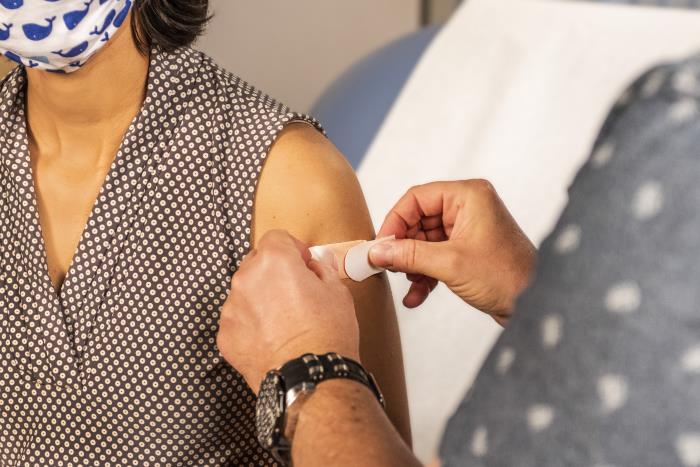Mink husbandry workers will likely be included in the second vaccination phase, accounting for about 300 people, according to the vaccine subpanel of the State Disaster Medical Advisory Committee.
The 17-member panel debated the lineup late last week. The committee advises the state’s health agency regarding medical ethics during a declared disaster or public health emergency, taking into consideration guidelines from the federal Advisory Committee on Immunization Practices.
The state panel decided to add mink husbandry to the list over concerns that there could be human-to-mink and then mink-to-human transmission of the virus, said committee co-chair Dr. Jonathan Temte of the UW-Madison School of Medicine and Public Health.
The ferret-like mammals have raised alarm around the world after serving as transmission vectors for COVID-19 and passing mutated versions back to people. The Badger State is ranked first in the nation for producing mink pelts.
Mink have a protein receptor in their lungs that may make them more vulnerable to the virus, explained Kevin Hoffman, public information officer at the Department of Agriculture, Trade and Consumer Protection.
He told WisBusiness.com that two Wisconsin farms have had COVID-19 outbreaks in mink. Both of these are located in Taylor County.
“Nearly 5,500 mink died naturally at the two farms after being infected,” he said.
Denmark had culled nearly 17 million mink due to the virus in November. The “Cluster 5” strain that was identified in Denmark has not been detected in Wisconsin, Hoffman said.
“We are working with the CDC and other agencies to monitor the affected farms,” he said. “Both farms remain under quarantine and there is ongoing testing.”
People ages 70 and older, first responders, teachers, corrections workers, and those living and working in congregate facilities, including incarcerated people, may also be the second group in Wisconsin to get the coronavirus shot.
This tallies up to about 850,000 people.
Federal guidelines recommend the second phase of vaccinations include people older than 75, first responders, teachers and corrections workers.
The state panel decided to expand the age group to those older than 70 because Wisconsin is an “old state,” Temte said. He added that the expanded age range would include more people with co-morbidities, covering roughly 550,000 people.
The committee debated the inclusion of those in congregate living facilities and the inclusion of incarcerated people in that group, which together total about 100,000 people.
“In a correction population, where we’ve had probably 12,000 positive cases … I don’t see how we move forward and not address this population,” Department of Corrections Chief Nursing Officer Mary Muse said. “We cannot ignore this population and we cannot push them back. Even if our correction workers are being vaccinated, that still does not address people who cannot decide on themselves or go to a clinic somewhere else in the community.”
Temte said it’s not ethically defensible to exclude incarcerated people from congregate living, because by definition, it is congregate living and high-risk for coronavirus spread.
While the majority of the panelists on the call voted to approve the above recommendations for the second phase, three members on the call did not support the motion. The reasons were for either including too many groups or not including enough.
Rob Gundermann, president and CEO of the Coalition of Wisconsin Aging and Health Groups, said expanding the second group of eligible people beyond the federal guidelines would slow the vaccination process and make it difficult to administer the vaccine.
“I think if we can get through this next phase quickly, then we can move into the next phase more quickly,” he said as he opposed the majority’s recommendation. “This is very difficult logistically and if we can keep this phase 1B as narrow and as tight as possible, we can get through it as quickly as possible.”
Others felt that many groups are still wrongfully left out. Non-face-to-face health care personnel had been omitted from the list, not making the cut for the next phases.
“We need some of those non-face-to-face health care personnel to be able to continue our health systems,” said Dr. Rajiv Naik of Gundersen Health System. He voted with the majority — recommending the elderly, first responders, teachers and those in congregate living, including prisons, for the second phase of vaccinations.
But Naik also pointed to other groups that could have been included, such as information systems workers to help prevent cyberattacks on health systems and operations people who implement vaccine plans.
Janet Zander from the Greater Wisconsin Agency on Aging Resources, said public transportation workers need to be in the next phase because of their role in getting food and health care supplies around the state. She was one of the three to vote against the majority.
Attorney Mitchell Hagopian with Disability Rights Wisconsin echoed Zander and added that food and agriculture service workers should be included, too. Public transit, USPS, grocery store, and food and agriculture workers would add another 115,000 people to the count.
The Department of Health Services has the final say in how the committee’s recommendations are implemented. As of Friday, DHS reports it has administered 123,402 doses of the 266,675 doses the federal government has shipped to the state.
The panel expects to have its report out tomorrow. The team will meet tomorrow morning to discuss whether secondary education instructors should be included and vote on a final recommendation.
-By Stephanie Hoff
WisBusiness.com






